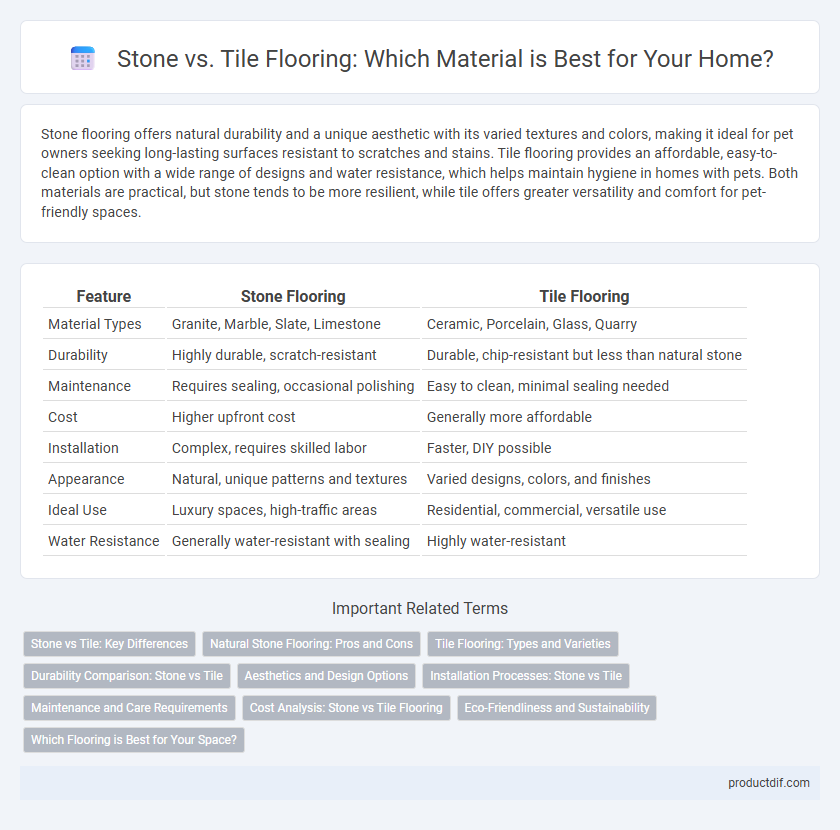Stone flooring offers natural durability and a unique aesthetic with its varied textures and colors, making it ideal for pet owners seeking long-lasting surfaces resistant to scratches and stains. Tile flooring provides an affordable, easy-to-clean option with a wide range of designs and water resistance, which helps maintain hygiene in homes with pets. Both materials are practical, but stone tends to be more resilient, while tile offers greater versatility and comfort for pet-friendly spaces.
Table of Comparison
| Feature | Stone Flooring | Tile Flooring |
|---|---|---|
| Material Types | Granite, Marble, Slate, Limestone | Ceramic, Porcelain, Glass, Quarry |
| Durability | Highly durable, scratch-resistant | Durable, chip-resistant but less than natural stone |
| Maintenance | Requires sealing, occasional polishing | Easy to clean, minimal sealing needed |
| Cost | Higher upfront cost | Generally more affordable |
| Installation | Complex, requires skilled labor | Faster, DIY possible |
| Appearance | Natural, unique patterns and textures | Varied designs, colors, and finishes |
| Ideal Use | Luxury spaces, high-traffic areas | Residential, commercial, versatile use |
| Water Resistance | Generally water-resistant with sealing | Highly water-resistant |
Stone vs Tile: Key Differences
Stone flooring offers natural durability and unique patterns with materials like granite, marble, and slate, providing a high-end aesthetic and greater lifespan compared to tile. Tile flooring, often made from ceramic or porcelain, allows for more design versatility, easier installation, and typically lower cost with water-resistant properties suitable for moisture-prone areas. While stone requires sealing and regular maintenance to prevent staining and damage, tile is generally more low-maintenance and resistant to wear and scratches.
Natural Stone Flooring: Pros and Cons
Natural stone flooring offers exceptional durability and timeless aesthetic appeal, featuring materials like granite, marble, and slate that provide unique textures and patterns. It excels in heat resistance and adds significant property value but requires regular sealing and maintenance to prevent stains and damage. The initial installation cost is higher compared to ceramic or porcelain tiles, and stone's porous nature can lead to moisture absorption if not properly treated.
Tile Flooring: Types and Varieties
Tile flooring comprises various types including ceramic, porcelain, and natural stone tiles, each offering distinct durability, water resistance, and aesthetic qualities. Porcelain tiles are dense and less porous, making them ideal for high-traffic and moisture-prone areas, while ceramic tiles provide versatile design options with easier installation. Mosaic, subway, and patterned tiles expand creative possibilities, enhancing the customization and overall appeal of residential and commercial flooring spaces.
Durability Comparison: Stone vs Tile
Stone flooring, such as granite or marble, offers superior durability due to its natural hardness and resistance to scratches and heavy wear, making it ideal for high-traffic areas. Tiles, including ceramic and porcelain, provide good durability but may chip or crack under heavy impact, requiring occasional repairs or replacement. Overall, stone outperforms tile in long-term resilience, sustaining its structural integrity and visual appeal much longer in demanding environments.
Aesthetics and Design Options
Stone flooring offers natural variations and unique textures that create a timeless, luxurious aesthetic ideal for both classic and contemporary interiors. Tile provides a vast array of colors, patterns, and finishes, allowing for highly customizable design options that can mimic other materials or introduce bold artistic elements. Both materials enhance visual appeal, but stone emphasizes organic elegance while tile prioritizes versatility and creative expression.
Installation Processes: Stone vs Tile
Stone flooring installation requires precise cutting and sealing due to its natural variation and porosity, often demanding professional expertise for proper handling and durability. Tile installation involves laying a uniform substrate, applying mortar, setting tiles with spacers for consistent grout lines, and sealing grout to prevent moisture damage. Both materials necessitate careful surface preparation, but tile installation is typically more standardized and faster compared to the labor-intensive process of stone flooring.
Maintenance and Care Requirements
Stone flooring requires regular sealing to prevent staining and damage from moisture, while tiles are generally more resistant to water and stains, needing only routine cleaning with mild detergents. Maintaining stone surfaces often involves periodic polishing to preserve their natural luster and prevent scratches, whereas tiles typically maintain their appearance with grout cleaning and occasional resealing. Both materials benefit from prompt spill cleanup, but stone demands more specialized care to avoid etching and surface deterioration over time.
Cost Analysis: Stone vs Tile Flooring
Stone flooring typically incurs higher costs due to material expenses averaging $15 to $30 per square foot and installation fees ranging from $10 to $25 per square foot. Tile flooring offers a more budget-friendly option, with material prices typically between $1 and $20 per square foot and installation costs around $5 to $10 per square foot. Homeowners should consider longevity, maintenance, and aesthetic preferences alongside initial investment when conducting a cost analysis between stone and tile flooring.
Eco-Friendliness and Sustainability
Natural stone flooring offers superior eco-friendliness due to its durability, low maintenance, and minimal processing compared to tile, which often requires energy-intensive manufacturing and chemical treatments. Stone's longevity reduces the need for frequent replacements, cutting down on waste and resource consumption over time. Recycled and locally sourced stone materials further enhance sustainability efforts in flooring choices.
Which Flooring is Best for Your Space?
Stone flooring offers unmatched durability and natural beauty, making it ideal for high-traffic areas and outdoor spaces, while tile flooring provides greater design versatility with various patterns, colors, and sizes suitable for kitchens and bathrooms. Stone materials such as granite, marble, and slate are heat-resistant and add long-term value to your home, whereas ceramic and porcelain tiles are moisture-resistant and easier to maintain. Selecting between stone and tile depends on your room's function, desired aesthetic, and budget considerations for installation and upkeep.
Stone vs Tile Infographic

 productdif.com
productdif.com